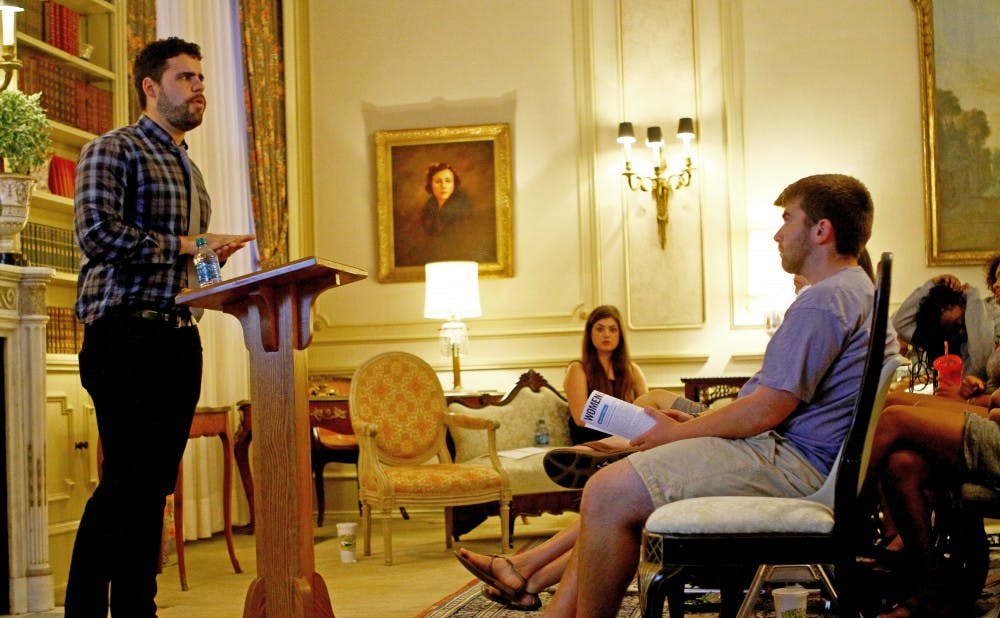What rhymes with perpetuation of racial and sexual stereotypes?
Students and scholars packed the East Duke Parlor to discuss the sexual politics of Robin Thicke’s controversial “Blurred Lines” music video and performance with Miley Cyrus at the 2013 Video Music Awards in a Duke Women’s Studies event called Twerking Class Heroes Tuesday night. The event featured a panel talk, followed by an open floor discussion on the sexual, racial and societal implications of Cyrus’ and Thicke’s performance.
Ranjana Khanna, Margaret Taylor Smith Director of women’s studies, addressed the strong reaction to Cyrus’ appearance at the VMAs—which included a provocative dance fad called “twerking.” The performance raised questions about sexuality, race, stereotyping and the degradation or empowerment of women as an implication of her performance.
“Is it disgusting, is it sexy, are those two things in opposition, or do they exist in a continuum?” Khanna asked the audience. “How can we understand the production of sexuality through such images?”
After playing the “Blurred Lines” video, which featured topless women riding bikes and holding lambs alongside Thicke, panel speakers spurred a conversation on the historical representation and sexualization of women. Clare Counihan, research scholar of women’s studies, said the music video and lyrics—including the line “Tried to domesticate you/But you’re an animal, baby, it’s in your nature”—liken women to animals.
“Animals don’t wear clothes, therefore women are a lot closer to animals than if they were wearing clothes,” said Counihan, adding the notable contrast between the topless women and Thicke’s formal attire in the video. “There’s a clear sense of who has power and who has civilization from how they’re dressed.”
Counihan also noted that the point of the discussion was not to draw blame or critique Thicke’s video.
“It’s not to say, ‘Bad Robin Thicke, bad Pharrell, bad T.I. for turning women into animals,’” she said. “That in and of itself is bad, but it’s important to think about why. What does it accomplish in the video, in the song, in making that connection?”
The video was “a self-parody of sorts,” said Gabriel Rosenberg, panel speaker and assistant professor of the practice in women’s studies. The absurd plot and contradictions of Thicke’s bravado—such as his dissatisfaction despite bragging about the size of his genitalia—suggest that Thicke realizes that the video is degrading, but wants the audience to know that it is only in a personal fantasy setting.
“It’s a theme party where the theme is sexual degradation,” Rosenberg said.
The panel also presented a direct parody of the video by musical satire group Mod Carousel, in which the women performed the song while in suits and male background dancers wore wigs and make up. Rosenberg lauded the parody’s depiction of gender fluidity, but felt a truly successful parody would have better addressed the concept of sexual fantasy versus power distribution in the real world that arose in the original “Blurred Lines” video.
The conversation turned to the “We Can’t Stop/Blurred Lines” medley performance at the VMAs, for which Cyrus received backlash for her provocative twerking. Counihan spoke of the representation of black women in relation to Cyrus’ backup dancers, who were described as faceless sexual objects behind a white performer.
Counihan stressed the importance of discussing Cyrus’ exploitation of black women’s sexuality, regardless of whether or not the singer was making a deliberate statement.
Undergraduate presenter Danielle Nelson, a senior, said Cyrus used racial imagery in her performance as a means to adopt a new identity beyond her initial public persona as a “good girl” Disney star. Nelson also spoke of Cyrus as “a brand, an image that is bought and sold,” and addressed the potential commercial intentions Cyrus’ VMAs appearance might have had.
After the panel talk, attendees brought up other videos and performances, including Macklemore’s performance of “Same Love” at the VMAs, which Rosenberg said earnestly supported same-sex marriage in comparison to Thicke’s parody of women’s rights.
Another audience member referenced Madonna’s 1989 music video for “Like a Prayer,” which received positive reviews despite controversy surrounding its content.
The discussion transitioned into the overarching issue of twerking as a cultural stereotype for black sexuality, and the widespread oversimplification of the racial and cultural genealogy of the dance.
Attendees continued to return to the point that Cyrus and Thicke’s actions were either an effort to sell an identity, particularly Cyrus’ desire to diverge from her child star roots, or a simple commentary on prevalent topics of society. One student noted that many performers seek to provoke reaction from the public.
“It’s really wonderful and productive to use pop culture as a way to talk about really nuanced arguments that need a pop culture event to clue us in and make us aware of the issue,” Nelson said. “Otherwise we wouldn’t have a chance to sit down and talk and unpack these complicated and very historically ingrained issues.”
Annu Dahiya, a Ph.D. candidate in literature, said she was pleased that enough students cared about the issue to fill the room.
“It’s really great to start tracing the genealogy and history of these different discourses beyond the ‘Wow, this is horrible’ instantaneous factor,” Dahiya said. “It’s good that undergrads and grads alike are thinking more about the lineage of these problems.”
Get The Chronicle straight to your inbox
Signup for our weekly newsletter. Cancel at any time.

